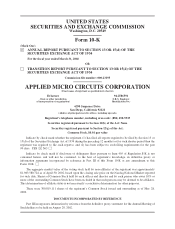3Ware 2002 Annual Report Download - page 9
Download and view the complete annual report
Please find page 9 of the 2002 3Ware annual report below. You can navigate through the pages in the report by either clicking on the pages listed below, or by using the keyword search tool below to find specific information within the annual report.Products and Customers
Transition from ASICs to ASSPs
Application specific integrated circuits (“ASICs”) are custom products that are designed for only one
customer and can be sold only to that one customer. Application specific standard products (“ASSPs”) are
standardized products that are designed for, and can be used by, multiple customers. Our customers are looking
for ways to accelerate their time to market, reduce research and development cost, and ensure interoperability of
components in their systems. ASSPs generally can be designed into the systems and brought to market in less
time and for less cost. As more companies realize the development cost and time-to-market benefits that ASSPs
provide, the more apt they are to use ASSPs in the future. Most of our products are ASSPs, and we believe that
the trend towards greater usage of ASSPs in communication network systems will continue.
We have several types of communications IC products which are categorized by the order in which they
receive and transmit signals and information within communication equipment. These categories are:
PMD Layer: Our PMD layer ICs typically work in conjunction with the lasers or photo diodes that
provide the electrical-to-optical and optical-to-electrical signal conversions. These ICs include various amplifiers
that take very weak analog electrical signals (e.g. a few millivolts) and increase them for use by the physical
layer. Our PMD layer products transmit signals at rates ranging from 1 to over 40 gigabits per second (“Gbps”).
Physical Layer: Our physical layer ICs transmit and receive signals to and from the PMD layer in a very
high-speed serial format (over 40Gbps today) and reduce overall system “noise”. This low noise capability
permits the transmission of signals over greater distances with fewer errors. Our physical layer ICs also convert
analog signals from the PMD layer to digital signals for the framing layer and vice versa.
Framing Layer: Our framing layer ICs transmit and receive signals to and from the physical layer in a
parallel format and are used predominately in systems, such as very high-speed transmission equipment, add-
drop multiplexers, digital and optical cross-connects, edge and core routers and DWDM. After receiving the
signals, these ICs then perform a number of additional functions, including framing, terminating the overhead,
performance monitoring, forward error correction and mapping the data payload to/from the transmission format.
The framing layer ICs then pass the data either directly to a switch fabric product which switches the information
to its destination, or to a network processor, which further processes the data prior to forwarding it to a switch
fabric product. Framing layer ICs similarly process signals received from the network processing and switching
layers for transmission to the physical layer on their return to the optical network.
Network Processing Layer: Our network processor ICs are software programmable processors that receive
and transmit signals from and to the framing layer and perform the processing of packet and cell headers,
including such functions as real-time parsing, matching and table look-up, as well as bit stream manipulations,
such as adding, deleting, substituting, appending and pre-pending. They can perform intelligent packet
classification for policy-based network services. After processing, the signals are sent on to the traffic
management and switch fabric layer.
Traffic Management and Switching Layer: Our traffic management ICs receive and transmit signals from
and to the network processor and primarily perform the queuing and buffering required on packets before the
information is sent to the switch fabric. Our switch fabric ICs then switch the information in the proper priority
and to the proper destinations.
Products
PMD Products: During fiscal 2001, we introduced our first generation OC-768 modulator driver,
10Gigabit ethernet transimpedance amplifier, and 10Gbps VCSEL laser driver and amplifier products. In
addition, we introduced our second generation 3.2Gbps VCSEL laser driver and amplifier products for use in
4






















